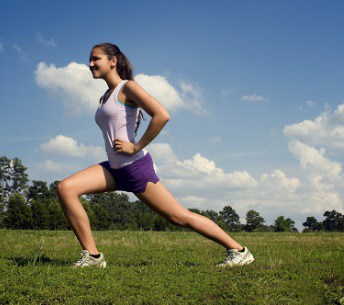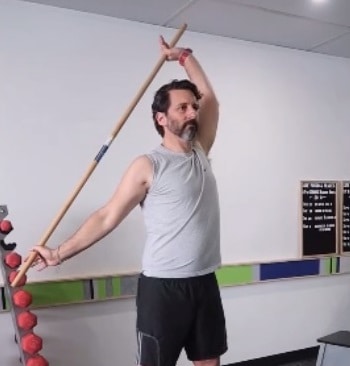
Dynamic Stretching
When putting a program together that includes the 5 best exercises that you can do before playing competitive sport; here are some things that need to be taken into consideration.
1) The type of sport
2) Where it’s played
3) The position that you spend most of your time in.
If you have any recent niggle’s that you should consider (like the achy back, the on and off tight calf…..)
These factors will influence the exercises that you should do prior to playing sports. So here are some generic exercises that you can do prior to playing sports. Following are some principles that you can apply before you begin.
Dynamic stretching is the most efficient way to warm up. As the name implies this involves movement and muscular effort for the stretch to occur.
While static stretching takes a muscle to its full length and holds it there for 15 to 60 seconds, a dynamic stretch takes soft tissues to their full length and rather than holding it, after a brief pause of 3 to five seconds, the muscle being stretched contracts and the muscles and tendons exert a force in that lengthened position.
In this way we can lengthen the muscle, strengthen it in its new range, and also work on balance and coordination. It also provides a good warm-up before a sport or activity. Dynamic stretching exercises have been shown to improve performance when done before an activity that requires a lot of power, strength or speed.
All movements during a dynamic stretch are done deliberately and slowly so as to avoid activating the stretch reflex at the end of the movement and movements used are those that mimic those movements used in a specific sport but in a controlled yet exaggerated manner.
A good example of dynamic stretch that covers a lot of your body in one efficient flow is the classic yoga move.
Salute To The Sun
This classic yoga move warms strengthens and aligns the entire body. It’s a series of poses performed in a sequence to create a flow of movement. Sun Salutations build heat in the body and are often used as warm-up for yoga practice.
Lunges
This movement stretches out hip flexors, calves, quads and more.
It can be performed as a dynamic stretch by lunge walking it, 10 forward, then 10 back.
Spine Twists
Place your feet securely about hip width apart. With your hands in front of your shoulders, keeping your pelvis facing forward, turn your upper body to take arms to each side, repeating about 10 times.
Leg Swings
Stand straight with your feet hip-width apart hold onto a wall if you need to steady yourself.
Standing on one leg swing the opposite leg smoothly forwards and back paying attention to maintaining your torso posture and core muscles activated to keep your back still.
Repeat around 10 repetitions on each side.
Shoulder Pole Broomestick Stretch
Standing with your feet at shoulder-width, toes pointing out, hold a pole/pvc pipe/broomstick in front of you. You can also do this stretch with a towel.
Make sure to brace your core before you lift the pole above your head in an arc motion. Keep the arms completely straight throughout.
Slowly move the pole behind you, focusing the stretch in the shoulders. Slowly return to the starting position.
There are many variations on this dynamic stretch – use your creativity but watch out for others around you!
Shoulder Broomestick Stretch - 1st Step
Shoulder Broomestick Stretch - 1st Step
Another good thing that you can do is to walk.
Walking is probably the best thing you can do for the lower half of your body. Making a big assumption – but most of us spend most of our weeks sitting down, and driving. Can you park away from the sport field so you get a 10 minute (at least) walk in before you start your sport specific warm up.
Walking with rhythmic long strides is your body’s perfect pump to get circulation joints and muscles prepared.
Experts suggest we should be walking 3-5km/day.
Not many of us manage that these days.
Sport/position specific requirements
Different types of sports place varying demands on your body, therefore it’s important that you tailor your exercise program around these demands.
For example, Footballers may need to prioritise their hamstrings on their kicking leg prior to playing football. Mountain climbers need to do isometric hangs and midfield players take part in sideways running.
Your Physio can help determine what the demands of the sport in conjunction with whatever challenges your body may have and tailor an exercise program around those demands.
Injury management
Professional and amateur sports people manage injuries and niggles throughout their sports season. If this occurs, it’s important to continue and manage the exercises that have been suggested or prescribed by your Physio. This may include simple stretching or muscle activation exercises, jumping and landing practice, or some skill related drills.
Cardiovascular warm up
This exercise is straightforward and relevant to all sports, cardiovascular exercise at low intensity, helps to get your blood flowing and your body ready for movement. It’s advised that this exercise is done at medium intensity, preparing your body for the final part of this program.
Agility work/high intensity preparation
When it comes to competitive sports, it’s important to be warmed up and ready to go. A quick running drill with a whistle blowing start, or some sort of partnered competitive drill is great preparation for the dynamic decision making that you need when playing sports.
If you need any more information or guidance regarding warm up exercises for a specific sport, you can make a booking with one of our Physios at your nearest practice.
This blog was written by Physio Nicole Brammy from the Adelaide City East Physio Practice.


